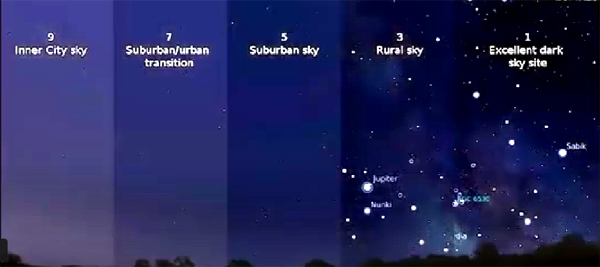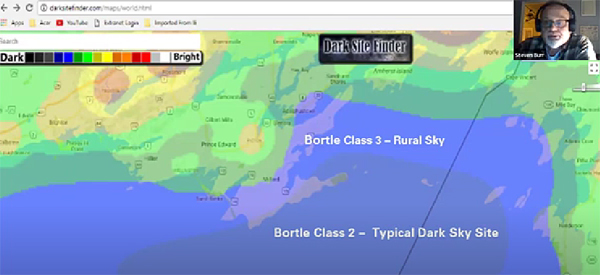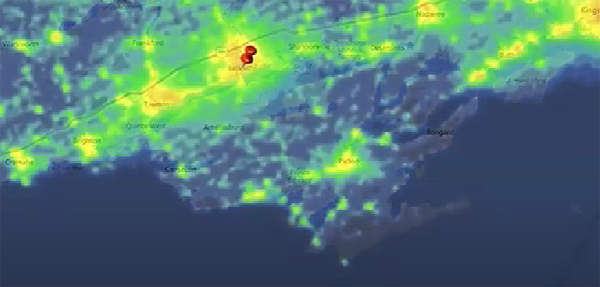Imagining a dark sky preserve at County’s South Shore
Administrator | Jan 28, 2023 | Comments 0

By Sharon Harrison
The night sky, and especially one seen without interference of external light pollution, enchanted viewers of a recent presentation hosted by the South Shore Joint Initiative (SSJI).
In their first event for 2023, the SSJI, a community group dedicated to protecting Prince Edward County’s south shore, welcomed South Marysburgh resident Steve Burr to explore people’s connection to the night sky.

Steve Burr
Burr is a member of the Royal Astronomical Society of Canada (RASC), Belleville division. The RASC, founded in 1868, is Canada’s leading astronomy association with more than 5,000 amateurs, educators and professionals, promoting astronomy for everyone. He is working toward a post-graduate diploma in cultural astronomy and astrology.
“As a society, we have lost our connection to the night sky; light pollution affects plants, animals and humanity,” he told the group.
Also forming part of the webinar discussion was the possibility of exploring a dark sky designation for the South Shore area of Prince Edward County.
“The South Shore of Prince Edward County is a critical migratory pathway and home to various plants, amphibians and reptiles. As such, light abatement should be embedded in its management.”
An informative virtual presentation on dark sky preserves followed an interesting short documentary on light pollution, and what erasing stars from the night sky means for everyday life, heritage and culture.
The documentary noted how millions of children will never see a sky full of stars due to the effects of light pollution – especially in urban areas.
“We are raising the first generation of children who haven’t seen starlight, but their parents haven’t seen it either,” noted the documentary, adding “As light pollution spreads, we are slowly losing one of the oldest and most universal links to all of human history.”
Burr explained that a dark sky preserve is a protected area that makes a special commitment to protect and preserve the night by reducing or eliminating night pollution, in all forms.
Light pollution, he explained, is unwanted, inappropriate or excessive use of artificial lighting.
“For those of us living today, we are for the most part, unable to see the night sky at all. We have subsequently lost our connection to the night sky.”
It was explained how there are three designations the RASC imparts on sites: “dark sky preserve”, “nocturnal preserve”, and “urban star park”.
“Dark sky preserve sites are very dark skies with minimal sky glow which are generally found far from urban centres,” explained Burr. “They are therefore less accessible to astronomers and the public, although usually these do contain public campgrounds.”
Some dark sky sites are remote with few resources for active outreach programs and are known as nocturnal preserves. They are designated more for the protection of the night for flora and fauna than for public amenities.
“Urban star parks are sites within or close to urban areas that are not considered “dark”, but provide good access to the public.”
Burr said there are three designations the South Shore can look at, should they be interested in establishing a dark sky preserve.
Mentioned as a nearby example, the North Frontenac dark sky preserve covers an area of 1,164 square kilometers, and was designated a dark sky preserve in 2013 and is the first municipality in Canada to achieve dark sky preserve status.
While no specific spot has yet been explored, and would be part of discussions between the SSJI, its partners and the public, Burr explained the area along the South Shore in South Marysburgh is being looked at for the possibility of establishing a dark sky preserve, an area that borders two ‘Bortle scale’ classes.
 “From Point Petre, straight to the bird sanctuary along the edge of the southern coast, it is Bortle class 2, which is a typical dark sky site,” Burr noted. “Further north in South Marysburgh, it is a Bortle class 3, which is rural sky, and as we get closer to Picton, we get more urban lighting.”
“From Point Petre, straight to the bird sanctuary along the edge of the southern coast, it is Bortle class 2, which is a typical dark sky site,” Burr noted. “Further north in South Marysburgh, it is a Bortle class 3, which is rural sky, and as we get closer to Picton, we get more urban lighting.”
He further explained if the SSJI were to explore the possibility of implementing a dark sky preserve on the South Shore, there would be three phases to the procedure to reach the designation status.
The phases include coordination of community partners in phase one, outreach and education in phase two, and implementation and monitoring in the third phase.
“I don’t foresee the whole County being designated as a dark sky preserve, but I’m hoping we can protect the South Shore area, at least.”
A celestial viewing location would have to be determined, an area Burr describes as a public space with amenities, including observation pad, parking, accessible washrooms and electrical service.
One participant suggested the Hudgin Moses Log House on Ostrander Point Road would make a good location, but Burr had a few concerns.
“The road down to the Hudgin house, especially when people will be transporting several thousand dollars worth of optical gear, is concerning, but definitely a possible location.”
 A question and answer session followed where questions came in the form of when was the best time to experience a dark sky, what areas of the South Shore are being considered for a dark sky preserve, where are the best places to view a dark sky, and what bylaws could be implemented to ensure the elimination of unwanted light pollution.
A question and answer session followed where questions came in the form of when was the best time to experience a dark sky, what areas of the South Shore are being considered for a dark sky preserve, where are the best places to view a dark sky, and what bylaws could be implemented to ensure the elimination of unwanted light pollution.
Burr said municipal bylaws would help assist in the creation of a dark sky preserve in South Marysburgh.
“That doesn’t address the issue of how you engage individual landowners and commercial interests, which are simply expansionary in terms of how much they wish to develop parts of this part of the world,” she said.
“In phase one of the recommended implementation is education and that would be outreach where members of RASC and the local community would come out and present on light pollution, and hopefully we address the issues of landowners through education,” Burr reassured.
Someone else asked if flashing lights of wind turbines were a big contributor to light pollution.
While Burr said he was not an expert in light pollution, “the turbines on Wolfe Island and Amherst Island are quite a ways off, so the impact locally is very minimal.”
Burr said the best way for individuals to become involved in promoting the dark sky proposal initiative is to contact him to express interest, at steveburr100@gmail.com.
“If I get enough interest, and I get enough people interested in this project, maybe we will team up with the South Shore Joint Initiative, who would be a partner, and see if we can make something happen.”
Burr also suggested writing to municipal representatives expressing concern about the night sky and light pollution.
“Maybe we can get a municipal bylaw on light abatement for the County, like they do have in the city of Peterborough and in North Frontenac.”
And the best time of year to experience a dark sky?
“Whenever it is clear, any clear sky, anytime,” said Burr.
“We are really lucky in South Marysburgh as we have really dark skies we can take advantage off; in wintertime especially, the seeing is very good.”
The Imagining of a South Shore Dark Sky Preserve presentation can be viewed on the South Shore Joint Initiative’s YouTube channel.
The SSJI can be reached at ssji.ca, where current events are posted.
Filed Under: Featured Articles
About the Author:































